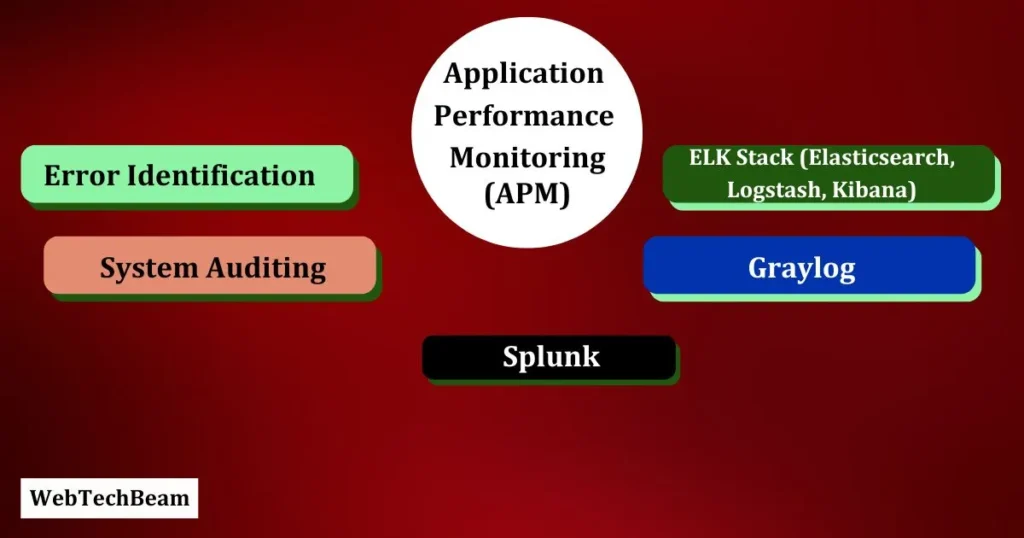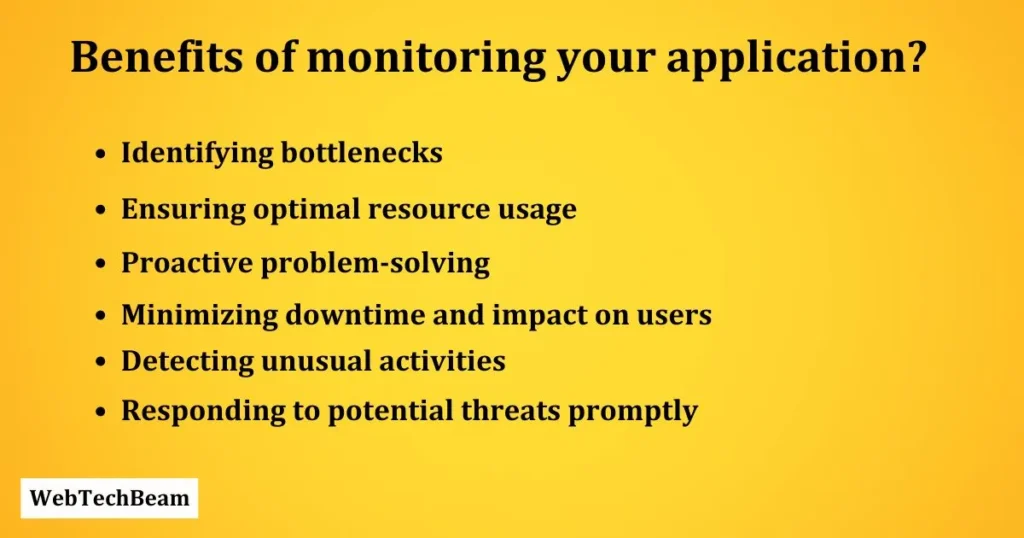Application monitoring is the ongoing process of monitoring and tracking an application’s performance and functionality. By actively monitoring the application’s operations, developers can promptly identify any potential issues or glitches. This is vital as it guarantees that the application remains dependable and efficient, resulting in a positive user experience.
Keeping applications robust and reliable results in reduced disruptions for users and more effective troubleshooting for developers, thereby ensuring smooth and efficient operation of the application in the long run.
In this post we will discuss in detail about Why Monitoring You Application is Important?
What Is Application Monitoring?
The act of application monitoring entails the ongoing observation and evaluation of an application’s performance, accessibility, and overall condition. This process involves gathering diverse metrics and logs, including response times, error rates, and resource utilization, to acquire a deeper understanding of the application’s operational status.
Developers and IT teams can utilize these data points to detect and troubleshoot problems, enhance performance, and guarantee that the application complies with its service level agreements (SLAs).
By implementing efficient application monitoring, organizations can proactively maintain their systems, reducing downtime, and enhancing the end-user experience through prompt resolution of any anomalies or failures that might arise.
Types of Monitoring Tools
Performance Monitoring Tools

Examples and features:
- New Relic: This tool offers real-time performance monitoring and detailed insights into application performance, including slow transaction traces and detailed error analysis.
- AppDynamics: Known for its comprehensive monitoring capabilities, AppDynamics provides detailed metrics on application health, end-user experience, and performance bottlenecks, making it easier to identify and resolve issues.
- Datadog: Datadog is a cloud-based monitoring tool that provides a unified view of metrics, logs, and traces from various applications, offering powerful visualizations and alerting capabilities.
Performance monitoring tools play a crucial role in ensuring the smooth and efficient operation of your application. By consistently monitoring diverse performance metrics, they facilitate the identification of bottlenecks, optimization of resource utilization, and provision of comprehensive insights into application performance.
Logging and Analytics Tools
Importance of logs:
- Error Identification: Logs are essential for identifying errors and understanding the circumstances under which they occurred.
- System Auditing: Logs provide a detailed record of all activities within the application, which is crucial for auditing purposes.
- Performance Monitoring: Logs can help monitor the performance of different application components and trace the source of issues.
Tools for comprehensive analytics:
- Splunk: Splunk is an analytics tool that turns machine data into operational insights. It offers real-time search, analysis, and visualization of logs, helping to monitor and troubleshoot performance issues.
- ELK Stack (Elasticsearch, Logstash, Kibana): This open-source toolset helps in collecting, analyzing, and visualizing log data. Elasticsearch provides powerful search capabilities, Logstash processes and transforms log data, and Kibana offers rich visualizations.
- Graylog: Graylog is another open-source tool that focuses on log management and analysis. It allows for real-time log analysis and provides a highly configurable dashboard for visualizing log data.
By capturing and analyzing log data, logging and analytics tools offer valuable insights into the performance and user interactions of an application.
Security Monitoring Tools
Ensuring application safety:
The detection and prevention of potential security threats are crucially supported by security monitoring tools, ensuring the protection of applications.
Popular security monitoring tools:
- Snyk: Snyk focuses on identifying and fixing vulnerabilities in an application’s dependencies, container images, and code. It integrates seamlessly with development workflows to ensure security from the early stages of development.
- Snort: Snort is an open-source network intrusion detection system (NIDS) that monitors network traffic for suspicious activity and alerts users when such activities are detected.
- OSSEC: OSSEC stands for Open Source Security Event Correlator. It is a comprehensive open-source tool for monitoring and analyzing system logs, detecting intrusions, and ensuring compliance.
Developers can effectively safeguard applications against potential threats and maintain user trust by utilizing these security monitoring tools to protect sensitive data proactively.
These tools collectively form a comprehensive monitoring strategy, helping developers maintain optimal performance, ensure reliability, and secure their applications against potential threats.
What are the benefits of monitoring your application?

Performance Optimization
- Identifying bottlenecks:
The process of application monitoring is essential in identifying bottlenecks within the application that cause performance slowdowns. These bottlenecks can greatly impact the overall performance of the application if left unattended. Once these bottlenecks are identified, developers can take specific measures to address and resolve these issues, guaranteeing a seamless running of the application.
- Ensuring optimal resource usage:
Monitoring apps allows developers to track how resources such as memory, CPU, and bandwidth are being used. This helps in making sure that these resources are utilized efficiently. By optimizing resource usage, it is easier to avoid waste and ensure that the application performs well even under heavy load.
Early Detection of Issues
- Proactive problem-solving:
By implementing continuous monitoring, developers can identify potential issues before they escalate into critical problems. This proactive approach enables them to address these issues promptly, preventing any negative impact on users and guaranteeing a more dependable application. Detecting problems early on contributes to the long-term maintenance of the application’s robustness and stability.
- Minimizing downtime and impact on users:
By promptly identifying issues, developers can swiftly resolve them, resulting in minimal downtime. This translates to a more seamless user experience, with fewer disruptions while using the application. Consequently, this aids in upholding a favorable reputation for both the application and the company responsible for its development.
Improved Security
- Detecting unusual activities:
By monitoring, one can also keep a check on any abnormal activities occurring within the application, which could be potential security threats like unauthorized access attempts or unexpected data transfers. Identifying these activities promptly enables swift action to be taken, effectively preventing any possible security breaches.
- Responding to potential threats promptly:
When monitoring tools detect a potential threat, developers are promptly alerted for immediate action. This rapid response plays a critical role in minimizing the risk of security threats and maintaining the application’s security. Swift response times assist in safeguarding both the application itself and its users from potential harm.
FAQs
1. What is application monitoring?
Application monitoring involves the ongoing observation and analysis of different metrics and logs generated by software applications. The aim is to ensure that the applications perform optimally, remain reliable, and maintain their security. This practice assists developers in proactively identifying and resolving issues before they impact users.
2. Why is monitoring important for applications?
Monitoring is crucial because it aids in recognizing performance bottlenecks, optimizing resource utilization, identifying security risks, and reducing downtime. It guarantees that applications operate seamlessly, securely, and effectively, resulting in improved user satisfaction and the preservation of the application’s reputation.
3. What tools can be used for application monitoring?
A variety of application monitoring tools are accessible, comprising Splunk, ELK Stack, Graylog, Snyk, Snort, and OSSEC. These tools present distinct functionalities like log analysis, performance monitoring, and security threat detection, offering a comprehensive monitoring solution.
4. How does application monitoring enhance security?
By detecting abnormal activities that may indicate potential threats, such as unauthorized access attempts or unexpected data transfers, application monitoring boosts security. It also facilitates prompt response to these threats, reducing risks and safeguarding both the application and its users.
5. Can monitoring help in resource optimization?
Monitoring is beneficial for optimizing resources as it allows for tracking the utilization of resources such as memory, CPU, and bandwidth. Through analyzing these metrics, developers can ensure efficient resource usage, prevent unnecessary waste, and sustain application performance even during high usage scenarios.
6. What are the benefits of early detection of issues through monitoring?
Detecting issues early allows developers to address problems before they worsen and impact users. This proactive strategy reduces downtime, preserves the stability of the application, and guarantees a smooth user experience. Furthermore, it aids in sustaining the overall health of the application in the long run.
7. What is the Purpose of Application Monitoring?
The purpose of application monitoring is to monitor the performance and functionality of software applications. It aids in detecting problems before they have a significant impact on users or business operations. By gathering performance data, teams can evaluate the real-time health of the application.
8. Why is Monitoring Important?
Effective monitoring is crucial as it guarantees smooth and efficient operation of applications. It empowers teams to swiftly identify and address issues, thereby reducing any potential downtime. By diligently monitoring systems, organizations can enhance user satisfaction through consistent reliability and optimal performance.
9. Why Do We Need Application Performance Monitoring?
Application performance monitoring enables the assessment of application responsiveness and user satisfaction, offering valuable insights into resource utilization and facilitating more effective performance optimization strategies. Through identifying performance bottlenecks, teams can enhance application speed and reliability.
10. What is the Main Purpose of Monitoring?
The primary objective of monitoring is to ensure the well-being of software applications by effectively managing them. It empowers teams to meet user expectations and confidently fulfill service level agreements. Consistent monitoring helps identify patterns in performance, enabling informed decision-making.
11. How to Do Application Monitoring?
To do application monitoring:
- Effectively deploy monitoring tools to track essential performance metrics.
- Establish alerts to promptly inform teams about potential issues before they become more serious.
- Ensure that collected data is reviewed on a regular basis in order to identify patterns and enhance the overall performance of the application.
12. Why is Process Monitoring Important?
Monitoring processes is crucial because it guarantees the proper functioning of each application component, allowing for the identification of potential bottlenecks or issues that may lead to delays or failures. This practice enables teams to improve workflow efficiency and enhance the overall performance of the application.
Conclusion
Why Monitoring You Application is Important? Because its help for maintaining the health and performance of software applications. By continuously observing and analyzing application metrics, logs, and user interactions, developers can identify performance bottlenecks, resource inefficiencies, and potential security threats. Effective monitoring tools, such as Splunk, ELK Stack, Graylog, Snyk, Snort, and OSSEC, empower developers to proactively address issues, ensuring that applications run smoothly and securely.
Implementing proactive monitoring promotes a highly dependable and quick-to-respond application environment. By detecting issues at an early stage, developers can address them promptly, preventing their escalation and adverse effects on users. This method effectively reduces downtime, optimizes resource usage, and strengthens application security.
In the end, choosing to invest in comprehensive monitoring strategies leads to enhanced user satisfaction. This is because applications function reliably and securely, thereby strengthening the trust and reputation of the organization responsible for them.
Why Monitoring You Application is Important – Webtechbeam Best Info in 2024

